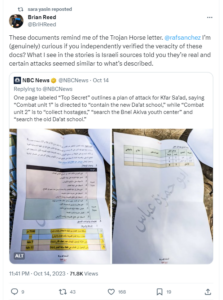After Hillary Manning, Los Angeles Times’ VP of communications, last week defended its editors and coverage of Israel’s war against Hamas as “committed to the standards of accuracy and fairness,” and promised “journalistic rigor, fairness and compassion,” the paper continues to pump out content which indicates otherwise.
Israel has declared war and continued to bomb and seal off the Gaza Strip, which Hamas controls, ever since Hamas militants attacked southern Israel on Oct. 7, killing more than 1,400 Israelis and taking at least 100 hostages into Gaza. At least 3,785 Palestinians, including 1,524 children and 120 older people, have been killed by Israeli airstrikes in Gaza as of Thursday, and at least 12,493 have been wounded, according to the Hamas-controlled Palestinian Health Ministry in Gaza. (Emphasis added.)

Raz Asher, 5, and her sister Aviv, 3, were kidnapped by Hamas with their mother and grandmother. Hamas is holding 30 children and between 10-20 senior citizens, data ignored by The Times even as it reported unreliable Hamas claims about young and old Palestinians killed in the Gaza Strip. The girls’ grandmother, Efrat Katz, was murdered during the kidnapping. (Photo from Instagram/Doron Katz Asher)
 Furthermore, it is remarkable that the LA Times journalists neglected to report that children and elderly — 30 children under the age of 16 and between 10-20 elderly civilians over the age of 60 — are held incommunicado by Hamas, an indisputable war crime, though their reporting does cite unreliable Hamas claims for young and old Palestinian fatalities in the Gaza Strip. This lopsided reporting is all the more stunning in light of the fact that Hamas issued directives to deliberately target civilians, especially children, for brutal murder and kidnapping. We previously documented that managing editor Sara Yasin has sought to discredit that information, retweeting the hyperlinked X post (screenshot at left).
Furthermore, it is remarkable that the LA Times journalists neglected to report that children and elderly — 30 children under the age of 16 and between 10-20 elderly civilians over the age of 60 — are held incommunicado by Hamas, an indisputable war crime, though their reporting does cite unreliable Hamas claims for young and old Palestinian fatalities in the Gaza Strip. This lopsided reporting is all the more stunning in light of the fact that Hamas issued directives to deliberately target civilians, especially children, for brutal murder and kidnapping. We previously documented that managing editor Sara Yasin has sought to discredit that information, retweeting the hyperlinked X post (screenshot at left).Egypt is continuing to keep its border with the Gaza Strip closed to Palestinians attempting to flee the Israeli bombardment of the territory, completing the construction of its concrete wall in the process.
Since the start of the Israeli aerial assault on Gaza which began after an offensive operation by the Palestinian resistance group last Saturday, Egypt closed its Rafah border crossing with the strip as many of its residents fled to the south of the besieged territory.
Then, earlier this week, The New Arab outlet cited a senior official Egyptian security source as saying that the Egyptian military “indefinitely” closed it due to the situation having “become quite dangerous after the Israeli bombardment of the Gaza Strip has had an impact on the Egyptian side of the crossing”.
According to images and reports circulating online, Egyptian authorities have now taken further steps to strengthen and reinforce the crossing by installing high concrete barriers on its side of the border.
 Also noteworthy is today’s page 3 print headline: “Wider Israeli airstrikes threaten to ignite broader war.” The subheadline continues: “Military continues its bombardment of Gaza as more aid arrives. Syria and West Bank are also targeted.” The Times headline deems the Israeli airstrikes — and not the Hezbollah or West Bank belligerence that precipitated the airstrikes — as threatening to ignite broader war.
Also noteworthy is today’s page 3 print headline: “Wider Israeli airstrikes threaten to ignite broader war.” The subheadline continues: “Military continues its bombardment of Gaza as more aid arrives. Syria and West Bank are also targeted.” The Times headline deems the Israeli airstrikes — and not the Hezbollah or West Bank belligerence that precipitated the airstrikes — as threatening to ignite broader war.
As Haaretz reported about the Israeli strike on the Jenin mosque:
The Israeli Air Force bombed on Sunday a mosque sheltering members of Hamas and Islamic Jihad, thought by security forces to be intending a murder spree like that seen in communities near the Gaza border two weeks ago. …
Israel Defense Forces spokesman Daniel Hagari said the targeted cell was “a ticking time bomb” that was “responsible for many terror attacks.
“It planned to commit a murderous attack in Israeli territory,” he continued. “The cell was attacked while in underground tunnels beneath the mosque.”
Imagine if West Bank terror groups succeed in pulling off a massacre akin to Hamas’ Oct. 7 bloodbath. Surely such a barbaric and devastating act of mass murder would open yet another front, threatening to ignite a wider war, to borrow The Times’ language. Fairminded and compassionate observers would conclude that in preventing such a horrific, widescale attack on civilians, the Israeli airstrike helped stem the risk of a wider war. The Los Angeles Times’ conclusion, however, was just the opposite: in preventing another act of mass murder of Jews, Israel threatened to ignite a wider war.
The accompanying AP story, reprinted in the Los Angeles Times, revealed no detail of the severity of the attack being planned in the Jenin mosque. Indeed, the article failed to convey the gravity of the thwarted attack meant to be an Oct. 7 massacre reprise, stating only:
The Israeli military said the mosque compound belonged to Hamas and Islamic Jihad militants who had carried out several attacks in recent months and were planning another one.
Likewise, reported Israeli airstrikes in Syria also are aimed at preventing precision weaponry with the potential to inflict huge harm to civilians from reaching the hands of Hezbollah, the Iranian-backed terror organization which is open about its aspirations to launch a Hamas-style inflitration and which only months ago boasted that Israelis “will be pulling bodies out from under the ruins.”
Notably, while the story was AP’s, the abominable headline blaming Israeli airstrikes for threatening to ignite a wider war, even as the very same airstrikes likely diminished the threat of a wider war, was uniquely The Los Angeles Times‘. Indeed, AP’s headline, free of the editorializing, was: “Second aid convoy reaches Gaza as Israel attacks targets in Syria and occupied West Bank.”
In addition, AP’s language — Israel attacks targets — more appropriately conveys legitimate military targets, while The Los Angeles Times’ wording — “Syria and West Bank are also targeted” — falsely implies that Israeli airstrikes indiscriminately fired on civilians.
Meeting the journalistic standards of accuracy, fairness, journalistic rigor and compassion requires more than issuing empty promises. It requires publishing content which actually answers to those criteria. On that front, The Los Angeles Times has miles to go.
